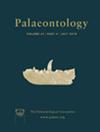连接浮游有孔虫的现存和化石记录:对球形虫谱系的影响
IF 2.3
2区 地球科学
Q1 PALEONTOLOGY
引用次数: 0
摘要
摘要对浮游有孔虫gloigerina falconensis plexus的现存和化石标本进行了形态计量学研究和壁结构分析。我们的全球数据揭示了化石种群和现存种群之间形态上的不一致。我们的研究结果具有重要意义,因为falconensis与其姊妹分类群G. bulloides一起被广泛用于古海洋学研究。在形态上,这两个物种是相似的,主要区别是独特的孔唇存在于G。falconensis。我们选择的岩心覆盖了整个地层范围。从中新世早期到现在的falconensis,横跨北大西洋和南印度洋的高纬度地区到赤道地区的地点。在现代海洋中发现的形态与在委内瑞拉中新世下沉积物中描述的Globigerina falconensis Blow中新世全型不一致。在中新世晚期进化出了一种更叶状的形态,因此,这种形态需要一个新的名称,与G共存于现代海洋中。Falconensis因此,我们描述了新的形态种,G。在中新世晚期进化并居住在现代海洋中的更瓣状的neofalconensis此外,我们报告了G。falconensis神经丛。我们利用PR 2数据库中的分子序列来探索G的一般归属。证实了其与G。球孢属的球孢及其保留。本文章由计算机程序翻译,如有差异,请以英文原文为准。
Bridging the extant and fossil record of planktonic foraminifera: implications for the Globigerina lineage
Abstract We conducted a morphometric study and wall texture analysis on extant and fossil specimens of the planktonic foraminifera Globigerina falconensis plexus. Our global data reveal morphological inconsistencies between fossil and extant populations. Our results are significant as G. falconensis is widely used in palaeoceanographic studies in conjunction with its sister taxon G. bulloides . Morphologically these two species are similar, with the main difference being the distinctive apertural lip present in G . falconensis . We selected cores covering the entire stratigraphic range of G . falconensis , from the early Miocene to current day, spanning sites from high latitudes in the North Atlantic Ocean and the southern Indian Ocean to sites in equatorial regions. The morphology found in the modern ocean is not consistent with the Miocene holotype of Globigerina falconensis Blow described from lower Miocene sediments in Venezuela. A more lobate morphology evolved in the late Miocene, thus, a new name is required for this morphotype, coexisting in the modern oceans with G . falconensis s.s . We thus describe the new morphospecies, G . neofalconensis for the more lobate forms which evolved in the late Miocene and inhabit the modern oceans. Additionally, we report a pseudocancellate wall texture present in the G . falconensis plexus. We use the molecular sequences from the PR 2 database to explore the generic attribution of the G . falconensis lineage, confirming its close relationship with G . bulloides and its retention in the genus Globigerina .
求助全文
通过发布文献求助,成功后即可免费获取论文全文。
去求助
来源期刊

Palaeontology
地学-古生物学
CiteScore
5.60
自引率
3.80%
发文量
43
审稿时长
6 months
期刊介绍:
Palaeontology publishes a wide variety of papers on palaeontological topics covering:
palaeozoology
palaeobotany
systematic studies
palaeoecology
micropalaeontology
palaeobiogeography
functional morphology
stratigraphy
taxonomy
taphonomy
palaeoenvironmental reconstruction
palaeoclimate analysis and biomineralization studies.
 求助内容:
求助内容: 应助结果提醒方式:
应助结果提醒方式:


